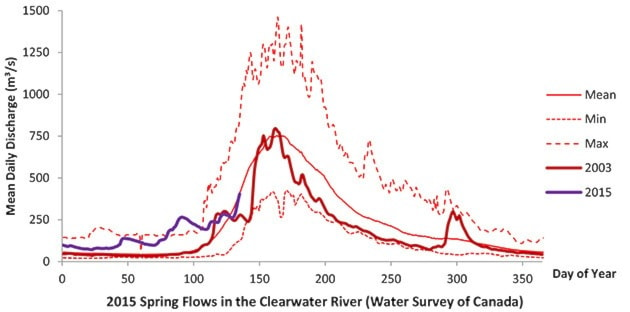Two graphs indicate that the upper North Thompson watershed could be facing an unusually dry summer, according to Michael Allchin.
The Clearwater resident is presently doing research towards a Ph.D. from UNBC.
The first graph, which shows the water flows in the Clearwater River, indicates that, so far this spring, the river has been running close to or above its long-term historical maximum.
“Substantially more runoff has already been lost to date this year than that at the same stage in 2003,” Allchin said.
“Over the three weeks from late March to mid April, the flows recorded were the highest ever gauged for these dates, since the gauge was established in 1914. There has not been much in the way of rainfall during this time, so the great majority of these flows have derived from melting snow.”
Allchin noted that earlier, faster snowmelt, in the absence of substantial subsequent rainfall, has been shown by several research studies to lead to lower levels of spring/summer soil moisture, and in turn to increased wildfire risks.
The second graph, which shows the amount of snow near Kostal Lake in Wells Gray Park, indicates that  mountain snowpacks are at lower levels than normal for this time of year, so less remains to maintain flows through the late spring and into summer.
mountain snowpacks are at lower levels than normal for this time of year, so less remains to maintain flows through the late spring and into summer.
On May 15, the Kostal Lake automated snow pillow reported 85 per cent of the 1971-2000 normal snow-water equivalent.
“While flows appear for now to be rising to their spring freshet peak at a rate similar to the long-term mean, they should be watched closely to determine if the peak occurs earlier, is lower, and/or lasts for less time, than usual,” Allchin said. “If this occurs, this is likely to correspond to lower soil moisture levels than normal, which in turn implies a higher wildfire risk.”
Allchin noted that the situation also could have implications for water supplies for North Thompson communities.
As reported recently in the Times, the BC Forest Service weather station in Clearwater recorded 16 mm of rainfall during April, compared to a 10-year average of 25 mm.
The governor of Washington state declared a statewide drought emergency on May 15. Snowpacks are 24 per cent of normal.
